
YOUR SEARCH UNCOVERED 2222 RESULTS
-
Robert Devereux, 2nd Earl of Essex (1565-1601)

-
10 November – Cats, pigeons and lions

On this day in Tudor history, 10th November 1536 (some sources say 1537), Sir Henry Wyatt of Allington Castle, politician, courtier, Privy Councillor and father of poet Sir Thomas Wyatt the Elder, died.
Sir Heny Wyatt was an important man, but rather than tell you about his career, Claire Ridgway, author of “On This Day in Tudor History”, thought she’d share with you two interesting stories concerning this Tudor man and cats, pigeons and a lion.
[Read More...] -
8 November – King Henry VIII praises one wife while trying to marry another!

On this day in Tudor history, 8th November 1528, at Bridewell Palace, King Henry VIII made a rather strange public oration to “the nobility, judges and councillors and divers other persons” to explain his troubled conscience regarding the lawfulness of his marriage to his first wife, Catherine of Aragon.
In today’s talk, I share an extract from the king’s speech, in which he praises Catherine of Aragon to the hilt even though he’d proposed to another woman, Anne Boleyn. Find out all about this strange situation!
[Read More...] -
6 November – Henry VIII abandons Catherine Howard
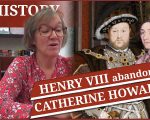
On this day in Tudor history, Sunday 6th November 1541, Catherine Howard, Henry VIII’s fifth wife, was abandoned by her husband the king at Hampton Court Palace. She would never see him again.
On the same day, Queen Catherine was visited by a delegation of king’s council members and informed of allegations made against her.
What exactly happened on this day in 1541 and what has this to do with Hampton Court Palace’s ‘Haunted Gallery’? Find out in today’s talk.
[Read More...] -
November’s live chats – 9 and 29 November 2019

We have two live chats in the Tudor Society chatroom this month, as usual. The first is our informal live chat on Tudor scandals, which will take place on Saturday 9th November, and the second is our expert live chat with Gayle Hulme on Mary, Queen of Scots, which will take place on Friday 29th November.
[Read More...] -
Live chat transcript – Lauren Johnson – Henry VI

Thank you so much to everyone who attended our October expert live chat with historian Lauren Johnson, and a big thank you to Lauren for being so giving of her time. It was a wonderful hour.
If you missed it, you can catch up with this transcript:
[Read More...] -
November 2019 – Tudor Life – Tudor Scandals

-
29 October – “Strike, man, strike” – The end of Sir Walter Ralegh

On this day in history, 29th October 1618, in the reign of King James I, Elizabethan courtier, explorer, author and soldier, Sir Walter Ralegh (Raleigh, Rawley, Ralagh, Rawleigh) was executed in the Old Palace Yard at Westminster Palace.
Ralegh had led an eventful life. He’d been a favourite of Elizabeth I – except when he secretly married her lady, Bess Throckmorton – but had been imprisoned in the Tower of London on several occasions, he’d been accused of atheism at one point, had sailed to America and tried to establish a colony, he was knighted for his service in Ireland, and he was a poet too!
Find out all about Sir Walter Ralegh’s colourful life in today’s talk.
[Read More...] -
27 October – Anne Boleyn makes an entrance

On this day in Tudor history, Sunday 27th October 1532, Anne Boleyn, Marquess of Pembroke, made a dramatic entrance to the great banquet held by King Henry VIII in Calais in honour of King Francis I of France.
I share details from contemporary sources regarding the banquet and the masque that followed. Anne Boleyn definitely knew how to make and entrance and the English ladies must have looked spectacular. You’ll recognise some of the names of Anne’s ladies and those present in Calais.
[Read More...] -
22 October – A Catholic baron who fled abroad

On this day in Tudor history, 22nd October 1577, Henry Parker, 11th Baron Morley and Roman Catholic exile, died in Paris. Morley had fled abroad in 1570 after refusing to subscribe to Elizabeth I’s “Act of Uniformity” and after being implicated in the 1569 Rising of the North.
Find out more about this Tudor man, who was the nephew of Jane Boleyn, Lady Rochford, and his rather interesting family, with their connections to the trial of Mary, Queen of Scots and the Gunpowder Plot, in today’s video.
[Read More...] -
18 October – Margaret Tudor, Queen of Scotland
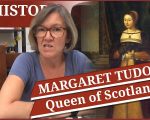
On this day in Tudor history, 18th October 1541, Margaret Tudor, sister of King Henry VIII and eldest daughter of King Henry VII, died of a stroke at Methven Castle, Perthshire, Scotland. She was laid to rest at the Carthusian Priory of St John in Perth, which was later destroyed.
Margaret Tudor is a fascinating Tudor lady. She was sent to Scotland at 13 to marry King James IV, she was widowed, divorced and unhappily married, she fled to England at one point, and she was the mother of Lady Margaret Douglas, grandmother of Mary, Queen of Scots AND Lord Darnley, and great-grandmother of King James VI of Scotland (King James I of England). What a life she had!
Find out all about Margaret Tudor in today’s talk.
[Read More...] -
11 October – A procession and prayers for Queen Jane Seymour

On this day in Tudor history, 11th October 1537, poor Jane Seymour was in labour with her first and only child, Edward VI.
It was a long and difficult labour, and on 11th October, there was a solemn procession in the city of London to pray for her. After about thirty hours, Jane gave birth to a healthy baby boy, who would become King Edward VI.
In today’s talk, I share contemporary sources about the procession and Jane’s labour.
[Read More...] -
10 October – Elizabeth I comes down with Smallpox

On this day in Tudor history, 10th October 1562, twenty-nine-year-old Queen Elizabeth I was taken ill at Hampton Court Palace, with what was thought to be a bad cold. However, Elizabeth actually had smallpox.
It was thought that the queen would die, so there was panic over the succession, and it was at this point that Elizabeth chose Robert Dudley as “protector of the kingdom”. However, Elizabeth I survived and went on to reign until her death in March 1603.
Elizabeth was nursed by her good friend, Mary Sidney, who also came down with smallpox and was badly disfigured by it.
[Read More...] -
Charles Brandon’s Marriage to Katherine Willoughby – Guest article by Tony Riches

Charles Brandon, Tudor knight and best friend of King Henry VIII, is best known for secretly marrying Mary Tudor, the king’s sister – without Henry’s permission! Less well known is his last marriage, to Lady Katherine Willoughby.
[Read More...] -
2 October – William Tyndale, Anne Boleyn and a book for “all Kings to read”

On this day in Tudor history, 2nd October 1528, reformer and Bible translator William Tyndale’s book “The Obedience of a Christian Man” was published in Antwerp.
A copy of this book owned by Anne Boleyn ended up being a catalyst of the English Reformation when it was confiscated from the suitor of one of Anne’s ladies as a heretical book. Henry VIII ended up reading it and proclaiming that “This Book is for me and all Kings to read.” It set him on his path to the break with Rome and saw him marrying Anne Boleyn as his second wife.
Find out the full story in this talk…
[Read More...] -
Edward VI – The good, the bad and the ugly
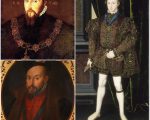
In this week’s Claire Chats talk, I am continuing my series on the Tudor monarchs, and examining their reigns for “the good, the bad, the ugly”, i.e. their achievements and the not-so-good stuff, by looking at the reign of the third Tudor monarch, King Edward VI.
Of course, Edward VI died before he reached his majority, so in examining his reign I have to look at “the good, the bad and the ugly” of the two men who led his government: Edward Seymour, Duke of Somerset, and John Dudley, Duke of Northumberland.
[Read More...] -
26 September – Sir Francis Drake, the Golden Hind and a whole lot of treasure

On this day in Tudor history, 26th September 1580, in the reign of Queen Elizabeth I, Sir Francis Drake returned from his 3-year circumnavigation of the Globe. Drake landed at the port of Plymouth, in his ship, The Golden Hind, which was laden with treasure and spices.
In today’s talk, I give details about his circumnavigation of the Globe, what he brought back, and how Queen Elizabeth I rewarded him for his efforts.
[Read More...] -
25 September – A pope, death cap mushrooms and poisoned candles
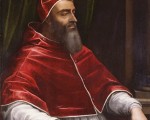
On this day in Tudor history, 25th September 1534, Pope Clement VII (Giulio di Giuliano de’ Medici) died in Rome. It was rumoured that he died from eating death cap mushrooms or from fumes from poisoned candles placed in his room, but it was more likely to have been from natural causes.
In today’s video, I introduce this pope, who was the leader of the Catholic Church at rather an interesting time, and also look at the rumours surrounding his death and what eating a death cap mushroom does. Lovely stuff!
[Read More...] -
22 September – Anne of Cleves, fourth wife of Henry VIII
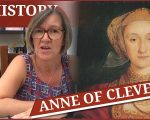
This day in Tudor history, 22nd September 1515, is the traditional birthdate of Anne of Cleves, or Anna von Jülich-Kleve-Berg, a woman who would become King Henry VIII’s fourth wife and queen consort, but only for six months!
She may have only been queen for six months, but Anne of Cleves outlived Henry and all of his wives, and seems to have had a very good life.
Find out more about her and how she came to be Henry VIII’s queen in today’s talk.
[Read More...] -
20 September – Arthur Tudor, Prince of Wales

On this day in Tudor history, 20th September 1486, King Henry VII’s wife, Elizabeth of York, gave birth to the couple’s first child at Winchester.
The baby was a boy and was baptised Arthur, named after the legendary King Arthur. There were high hopes for this boy and King Henry VII believed that his firstborn would be a powerful king who would bring a golden age to the country. Of course, things wouldn’t go according to plan.
Find out more about Arthur Tudor, Prince of Wales, who was, of course, Catherine of Aragon’s first husband, in today’s talk from Claire Ridgway, founder of the Tudor Society.
[Read More...] -
15 September – A Tudor Taxman – John Morton

On this day in Tudor history, 15th September 1500, in the reign of King Henry VII, John Morton, Archbishop of Canterbury, cardinal and Henry’s Lord Chancellor, died at Knole in Kent.
John Morton was not a very popular man with the English people due to his role in Henry VII’s financial policies, although at least he died of plague rather than being executed like his colleagues, Empson and Dudley.
One tax rationale he’s associated with is Morton’s Fork, but was it really down to him?
Find out the answer and find out more about this Tudor taxman in today’s talk.
[Read More...] -
14 September – Henry VIII, the shrine destroyer

Yes, on this day in Tudor history, 14th September 1538, a religious shrine which had stood since the early 12th century, was destroyed on the orders of King Henry VIII. The Shrine of Our Lady of Caversham was destroyed as part of Henry VIII’s Dissolution of the Monasteries.
In today’s talk, I share contemporary accounts of the shrine’s destruction, which included details of what was seized and sent to London.
[Read More...] -
10 September – Elizabeth I’s christening

On this day in Tudor history, 10 September 1533, King Henry VIII and Queen Anne Boleyn’s daughter, Elizabeth (the future Queen Elizabeth I), was christened at the Church of Observant Friars in Greenwich.
Elizabeth I’s christening service was a lavish ceremony presided over by Archbishop Thomas Cranmer, who also stood as the little girl’s godfather.
In today’s talk, I share a contemporary source of Elizabeth’s christening service and also of the celebrations that followed.
[Read More...] -
9 September – Catherine of Aragon and the mystery of James IV’s body

On this day in Tudor history, 9th September 1513, during the reign of King Henry VIII, English and Scottish forces clashed at the bloody Battle of Flodden.
Henry VIII was campaigning in France at the time, so Catherine of Aragon was in charge as regent. It was a victory for Catherine and also for Thomas Howard, Earl of Surrey, who led the English troops against the Scots on that day. Henry missed this moment of victory.
King James IV of Scotland died at the Battle of Flodden, but what happened to his body?
In today’s talk, I give details of the battle, Catherine’s role in England’s victory, and explains what is thought to have happened to James IV’s remains.
[Read More...] -
8 September – The mysterious death of Amy Robsart, wife of Robert Dudley

On this day in Tudor history, 8th September 1560, the body of Amy Dudley (née Robsart), wife of Robert Dudley, Earl of Leicester, was found at the bottom of some stairs in her rented home, Cumnor Place in Oxfordshire.
What had happened to Amy? Was her death a result of “misfortune”, as decided by the coroner, or was it suicide or murder? Did Robert Dudley kill his wife? Did William Cecil kill Amy?
In today’s talk, Claire Ridgway, founder of the Tudor Society, examines what happened that day and the theories regarding Amy Robsart’s mysterious death, an event that definitely put an end to the idea that Elizabeth I could ever marry Robert Dudley.
[Read More...] -
7 September – Birth of Queen Elizabeth I, Gloriana
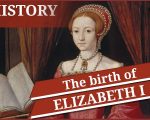
On this day in Tudor history, 7th September 1533, at Greenwich Palace, Queen Anne Boleyn, second wife of King Henry VIII, gave birth to a daughter who would grow up to be Queen Elizabeth I, the Virgin Queen, Gloriana, Good Queen Bess, a queen who would rule England for over 44 years.
Happy birthday to Queen Elizabeth I (1533-1603)!
Find out more about her birth, the reactions and celebrations in today’s talk.
[Read More...] -
Catherine Parr’s resting place
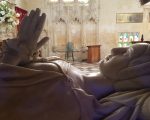
Today is the anniversary of the death of Catherine Parr, queen dowager, on 5th September 1548, so I thought I’d share some photos I took of her resting place in St Mary’s Church at Sudeley Castle:
[Read More...] -
1 September – Anne Boleyn becomes Marquess of Pembroke

On this day in Tudor history, 1st September 1532, in a special ceremony at Windsor Castle, King Henry VIII elevated his sweetheart Anne Boleyn to the peerage by making her Marquess of Pembroke.
This was a hugely significant act because Henry VIII made Anne a marquess in her own right, granted the title to her and her heirs male (legitimate or not) and gave her a title associated with his father, Henry VII, and uncle, Jasper Tudor. It also made her a rather wealthy woman, and a fitting consort for their trip to Calais to meet with King Francis I of France.
Find out more about what happened on this day in 1532, who was there, and just what Anne Boleyn was given by King Henry VIII, in today’s talk.
[Read More...] -
29 August – The sad story of Geoffrey Pole

On this day in Tudor history, 29th August 1538, Geoffrey Pole, son of Sir Richard Pole and Margaret Pole, Countess of Salisbury, was arrested. He was already on thin ice, having been a staunch supporter of Queen Catherine of Aragon and Princess Mary, but he now was suspected, like other members of his family, of being in communication with his brother, Cardinal Reginald Pole, a man who had upset King Henry VIII by writing a treatise against him and his policies.
Unlike other members of his family, including Margaret Pole, Geoffrey managed to survive this trouble – how? Why? What happened?
I explain all in today’s talk.
[Read More...] -
Courtiers and royal progresses – Claire Chats video

The summer months were the traditional time for the monarch and his/her consort to get out of smelly and disease-ridden London and to go on royal progress.
Now although the monarch owned many properties and estate dotted around the country, s/he would also ‘honour’ courtiers by choosing to visit them and stay with them while on progress. Can you imagine what a mixed blessing this was? How honoured you’d feel to be on the itinerary, but how worried you’d be at the cost of impressing the king or queen!
In this week’s Claire Chats video talk, I give some examples of courtiers who welcomed monarchs into their homes, just what was involved, what they did to try and impress, and what happened.
[Read More...]
